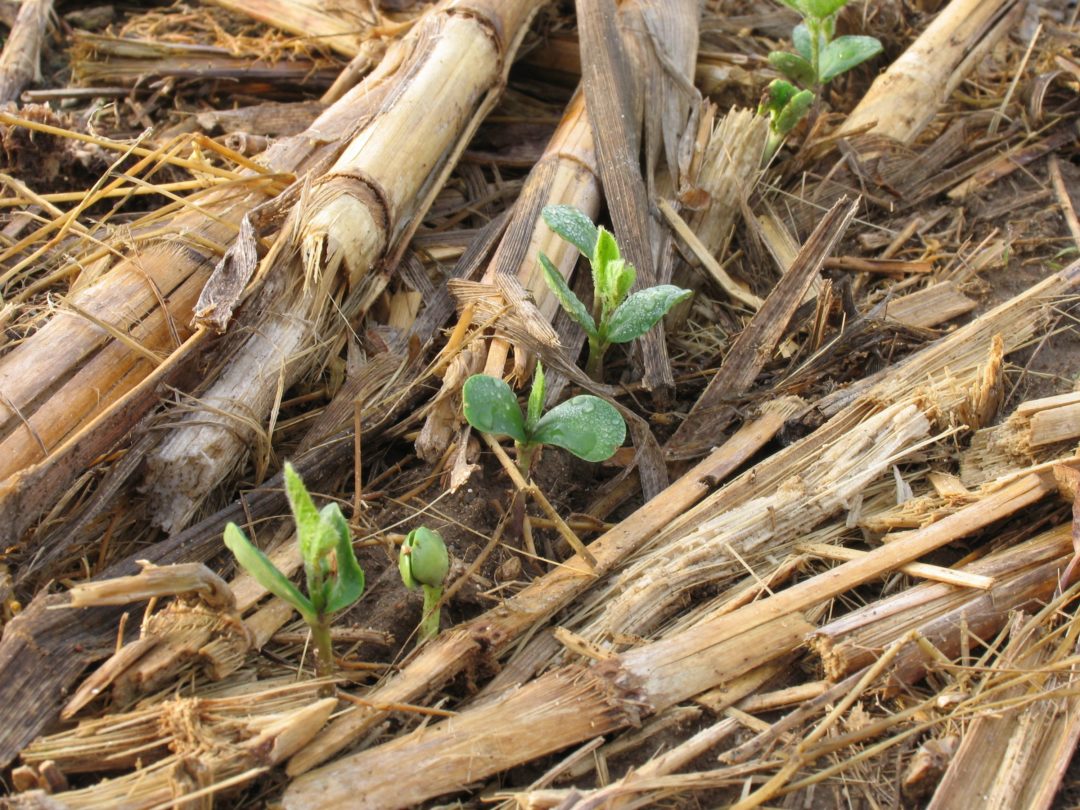Pictured Above: A recent study conducted by MSU Kellogg Biological Station scientists demonstrates significant benefit to both the environment and to crop yield for farmers practicing no-till versus tilled agriculture over many years. Pictured here are soybeans emerging through no-till corn residue on the KBS LTER site. Photo Credit: G.P. Robertson, MSU KBS
Despite the environmental benefits of no-till agriculture, farmers often hesitate to change to this management approach due to uncertain economic returns.
Sarah Cusser, postdoctoral research associate at the Kellogg Biological Station (KBS), and MSU terrestrial ecologist Nick Haddad, director of the Long-term Ecological Research (LTER) program at the Kellogg Biological Station (KBS) and professor in the Department of Integrative Biology, however, have just published a study in Global Change Biology that clearly demonstrates significant benefit to both the environment and to crop yield for farmers practicing no-till versus tilled agriculture consistently over many years.
Additionally, Haddad’s and Cusser’s work demonstrates the importance of long-term research for obtaining meaningful results, especially on the outcomes of management changes that can be slow to develop and to detect, such as the attributes of cropping systems on soil structure and organic matter. Unquestionably, studies of shorter duration than theirs would have produced misleading results.
“The findings drive home the importance of long-term studies because they reveal unexpected results,” Haddad said. “The typical duration for a grant is maybe five years. Our study shows that research of such short duration may be misleading. Certainly, for this study, there were many slices of time when we would have gotten the wrong answer, especially if the study had lasted less than 10 years.”
Using data from the KBS LTER program that began in 1989 to study how land use intensity affects agriculture and environment, Cusser, Haddad and colleagues explored the long-term agricultural and environmental effects of converting agriculture management practices from tilled to no-till.
“Every year for more than 30 years, the yield in no-till treatments increased versus the yield in tilled treatments – every year,” Haddad noted. “I would have expected a point where the yields and economic benefits reached their peak, but they continued to rise. It was jaw dropping.”
Based on assumptions about the financial investment required in converting from conventional tilling to no-till agricultural practices at the study’s onset, overall farmer profits were initially reduced, despite the increase in actual crop yields in no-till fields each year.
“The initial economic losses reflected the costs inherent in new equipment, chemical costs and labor input needed at that time,” Haddad said. “As these costs were met, profits rose. Even better, current farming practices eliminate these costs, such that the financial benefits of no-till practices accrue nearly immediately.”
Current data show that the increase in yield for corn, soy and wheat (in rotation) after 30 years is 40 bushels per acre (equivalent to one additional ton per hectare). Scientists know that yields from no-till initially increase because of its benefits to the environment, including greater moisture retention in the soil due to a higher percentage of organic matter. Why the yields continue to increase over 30-plus years, however, is not clear—and Haddad hopes to explore that question further.
The findings from this long-term study could benefit farmers substantially. Farmers who practice no-till often alternate this practice with standard tilling due to perceived differences in the corn and soybean response to no-till. In the short-term, there are likely to be yield drags from no-tilling corn—but not soybean. One of the key messages from this study is that continuous no-till farming practices have very positive economic and environmental benefits over decades.
Tim Boring, a 6th generation farmer in south central Michigan who grows corn, soybeans and small grains utilizing no-till practices, notes that this research articulates what many long-time no-till farmers know—that significant yield and profitability increases can be realized by reducing tillage.
“No-till is just one step in boosting the biological capability of the soil, improving nutrient cycling, water retention, water holding capacity and overall soil tilth,” Boring said. “Many producers today are finding that when paired with other conservation practices, such as cover crops, the economic return to moving away from conventional tillage can be realized.”
“In addition to Haddad and Cusser, other study co-authors are: Phil Robertson and Scott Swinton, MSU College of Agriculture and Natural Resources; and Christie Bahlai, Kent State University.
The Long-Term Ecological Research Program is one of the longest National Science Foundation (NSF) studies renewed consistently. Funded again in 2018, the KBS program is moving toward 36 years of ongoing research on the environment and agroecosystems, with the current four-year grant focused on resilience on different types of land use, from the most intensive—till and no-till—to the least intensive—organic and conservation grassland.







Post a comment
Report Abusive Comment